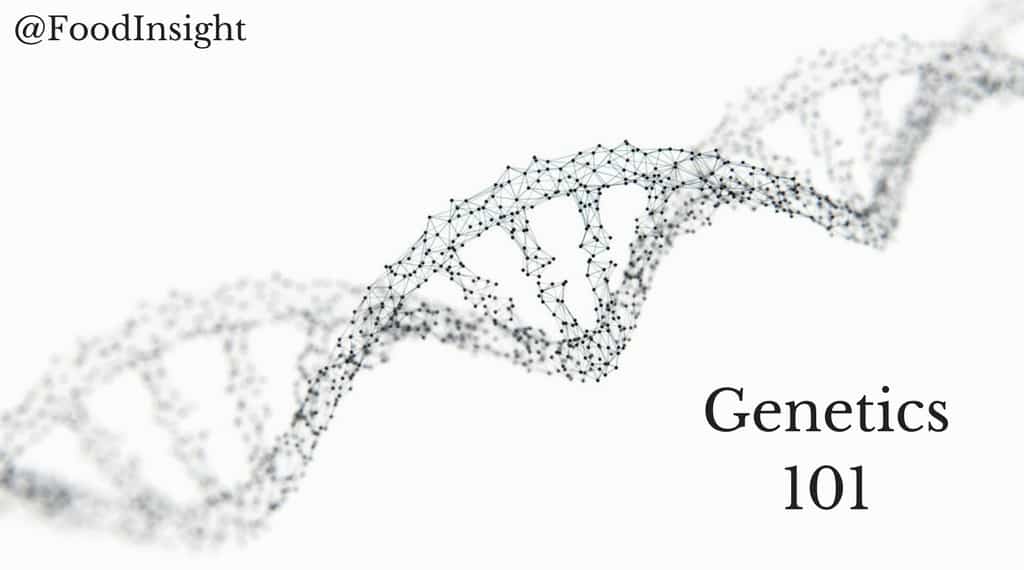“Genetic modification” and “genetic engineering” are terms we hear in relation to discussions about food production technology and the use of biotechnology for advancing our food supply. The US Department of Agriculture (USDA) has a great glossary to help you navigate the difficult terminology. But beyond definitions, what does food technology really mean? To answer this question, we thought it would be good to drill down and discuss what the word “genetic” means and how it comes into play in food production.
 All living things are made of cells. The cell contains cytoplasm and a nucleus, which is where DNA is found. |
“Genetic” refers to genes or DNA (deoxyribonucleic acid), which is the substance inside of the cells of organisms (living things—plants, fruits, vegetables, animals, people) that gives them their identity. So basically, the DNA of a tomato orchestrates a tomato being red, round, and having a soft skin.
DNA provides the foundation for characteristics of a living thing, but what comes after DNA? DNA will eventually give rise to the production of proteins—these proteins will perform a number of activities within the cell. You can think of proteins as busy little machines that make sure an organism can function—live, grow, and operate. And also, they give an organism its identity: plant versus animal, big bird versus small bird, green pepper versus yellow pepper—these characteristic traits boil down to protein production. All proteins have a job to do and are programed for specific tasks for the functioning of all living things.
How do we get from DNA to proteins? The “building blocks” of DNA are called nucleotides, and these are arranged in specific sequences to make a strand of DNA. You’ve heard that DNA is double stranded…well, maybe you’ve heard. DNA is typically made of two strands of nucleotides that are intertwined —think of two ribbons twirled together and they are being held together by an attraction between the nucleotides on each ribbon.
The DNA sequence of nucleotides is not random, it is a “code” that gets read or “decoded” to eventually make different proteins. Here are the steps:
1) The DNA sequence (or code) first gets “read” (transcribed) by cell machinery (made of proteins, called enzymes).
2) The transcribed DNA will yield a single-stranded (one ribbon) RNA or “ribonucleic acid.”
3) The RNA has a sequence of nucleotides (different than the DNA) that will then be decoded by cell machinery (translated).
4) Translation of RNA will yield the production of multiple proteins.
1) The DNA sequence (or code) first gets “read” (transcribed) by cell machinery (made of proteins, called enzymes).
2) The transcribed DNA will yield a single-stranded (one ribbon) RNA or “ribonucleic acid.”
3) The RNA has a sequence of nucleotides (different than the DNA) that will then be decoded by cell machinery (translated). 4) Translation of RNA will yield the production of multiple proteins.
 Protein production begins with DNA. The DNA is first turned into RNA, and then RNA will help to make multiple proteins. You can think of DNA as the ingredients for a cake and the RNA, the next step in making the cake, as the recipe. The final product, the protein, is the cake. |
As described, RNA is “translated” into proteins—which are made up of a chain of molecules linked together in a strand called amino acids. To picture a protein, envision a strand of beads (like a necklace) and each bead is an amino acid. The whole necklace is the protein.
DNA sequences can be changed by the insertion of a stretch of new nucleotides, the removal of nucleotide(s), or swapping one nucleotide for another. All of these methods have an influence on protein production. For example, the cells of mushrooms produce a protein that causes mushrooms to turn brown as they age or get bruised. By manipulating the protein production in a mushroom you can change this characteristic and stop the browning process from occurring.
 If the DNA (or cake ingredients) are changed (modified), this will result in a changed RNA (changed recipe) and ultimately, different protein production (a different cake). |
Hopefully this sheds some light on the term “genetic” and what it means to modify genes. It’s quite the process, but scientific advances in the realm of genetic modification are set to positively impact our food supply.
